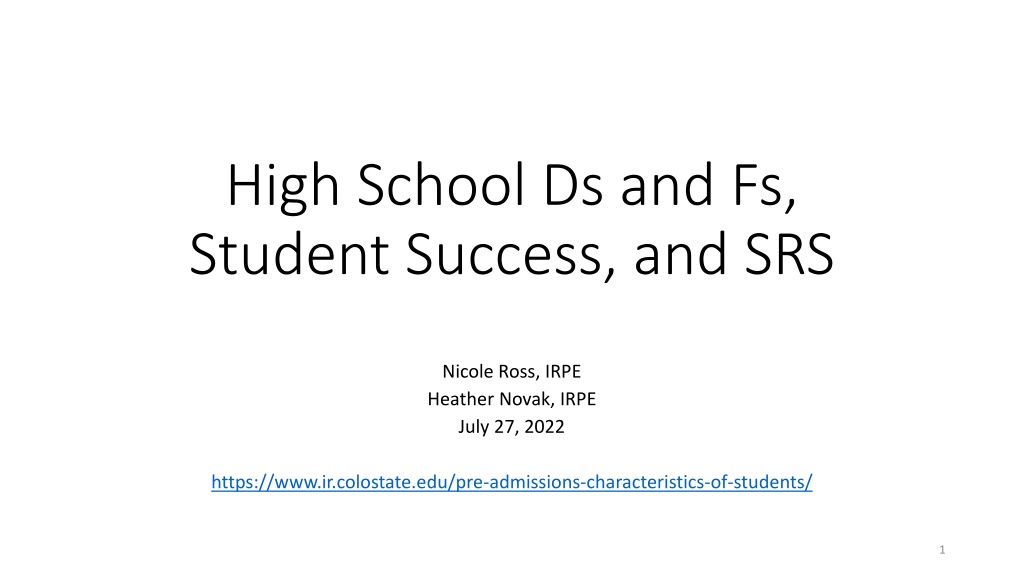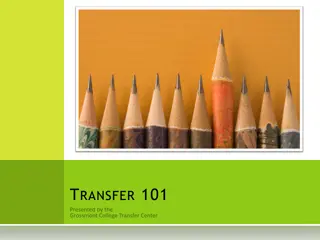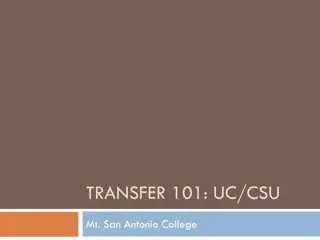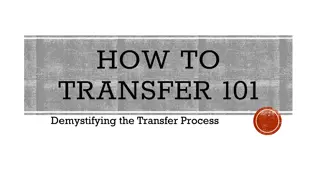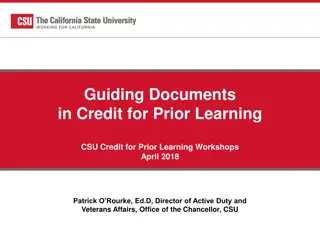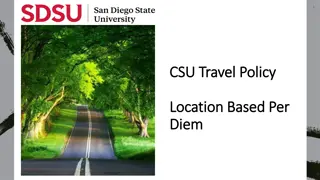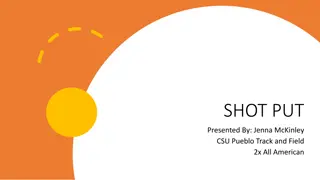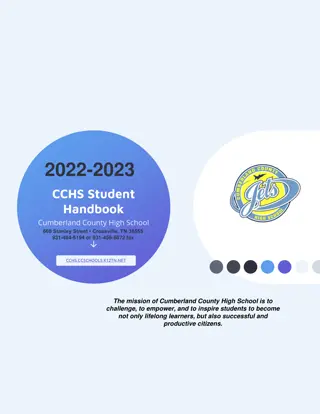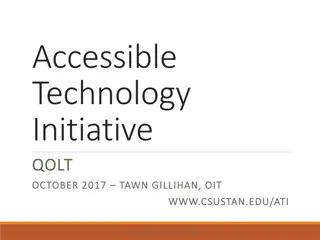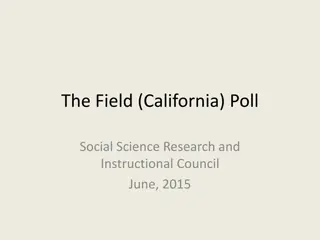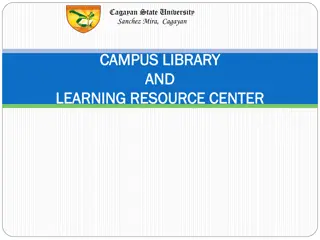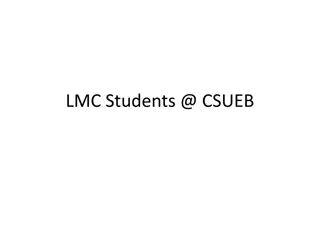High School Ds and Fs Analysis for Student Success at CSU
Analyzing the association between high school D or F grades and first-year success at Colorado State University (CSU). The study explores the usefulness of D or F grades as a metric for classifying students as Student Retention Students (SRS). Various methodological approaches like CART Analysis, Descriptive Picture, and Logistic Regression are used to examine the relationship. The findings suggest that CART Analysis did not produce meaningful results, highlighting the complexity in predicting outcomes based on high school D or F grades. However, grouping students into different categories showed interesting insights into student classification based on grades.
Uploaded on Oct 07, 2024 | 0 Views
Download Presentation

Please find below an Image/Link to download the presentation.
The content on the website is provided AS IS for your information and personal use only. It may not be sold, licensed, or shared on other websites without obtaining consent from the author. Download presentation by click this link. If you encounter any issues during the download, it is possible that the publisher has removed the file from their server.
E N D
Presentation Transcript
High School Ds and Fs, Student Success, and SRS Nicole Ross, IRPE Heather Novak, IRPE July 27, 2022 https://www.ir.colostate.edu/pre-admissions-characteristics-of-students/ 1
Purpose of the analysis Purpose of the analysis How are grades of D or F earned in high school associated with first-year success at CSU? Are high school D or F grades a useful metric for classifying a student as SRS? 2
Data Data FA19 Cohort New Students (5,077) Counts of D or F course grades by grade level 9th grade 10th grade 11th grade IR retention data (4,758) 12th grade 0, 1, 2, 3, 4, 5, 6+ Holistic Review (1,146) Course subject not specified SRS Other Reason (213) SRS Low Test Score (277) Non-SRS (656) 3
Counts of Ds/Fs Counts of Ds/Fs A high prevalence of zeroes A high prevalence of zeroes 4
What about cumulative counts? What about cumulative counts? 5
First Methodological Approach: CART Analysis First Methodological Approach: CART Analysis Training dataset (70% of sample) Test logic on testing dataset (30%) Evaluate accuracy of predictions Tree diagram of logic However, CART did not produce a meaningful result The tree diagrams from the training dataset were complicated( overfitted ) When applying the logic to the testing dataset, the model made no prediction Why? CART is most useful with very wide datasets (lots of variables) or very long datasets (many observations) Perhaps timing of Ds/Fs is not especially predictive 6
Second Methodological Approach: Descriptive Picture & Logistic Regression Second Methodological Approach: Descriptive Picture & Logistic Regression 7
Group students into 2 bins Group students into 2 bins Relative share with 1+ Ds/FS Non-SRS (656) 43.4% SRS Low Test Score (277) 40.4% SRS Other Reason (213) 70.9% 8
2 2nd nd fall persistence fall persistence Odds of 2nd fall persistence for 1+ Ds/Fs Groups Odds Ratio Relative to 0 Ds/Fs All students (n=548) .573*** 42.7% less likely SRS Other (n=151) .665 33.5% less likely SRS Low Test (n=112) .469*** 53.1% less likely Non-SRS (n=285) .611** 38.9% less likely 9
95% CIs of predicted probabilities for 2nd fall persistence 2 2nd nd fall persistence fall persistence 2nd Fall Persistence All Students Had 1+ Ds/F (n=548) 72.3% - 79.5% Had 0 Ds/Fs (n=598) 81.7% - 87.5% 2nd Fall Persistence SRS Other Students Had 1+ Ds/F (n=151) 68.6% - 82.3% Had 0 Ds/Fs (n=62) 72.7% - 91.8% 2nd Fall Persistence SRS Low Test Students Had 1+ Ds/F (n=112) 60.5% - 77.3% Had 0 Ds/Fs (n=165) 76.6% - 88.2% 2nd Fall Persistence Non-SRS Students Had 1+ Ds/F (n=285) 74.2% - 83.7% Had 0 Ds/Fs (n=371) 82.4% - 89.5% 10
Unsuccessful course attempt (D, F, W, or U) Unsuccessful course attempt (D, F, W, or U) Odds of an unsuccessful course attempt for 1+ Ds/Fs Groups Odds Ratio Relative to 0 Ds/Fs All students (n=548) 1.587*** 58.7% more likely SRS Other (n=151) 2.679*** 168% more likely SRS Low Test (n=112) 1.637* 63.7% more likely Non-SRS (n=285) 1.347* 34.7% more likely 11
Unsuccessful Course Attempt Unsuccessful Course Attempt 95% CIs of predicted probabilities for an unsuccessful course attempt All Students Unsuccessful course attempt Had 1+ Ds/F (n=548) 62.7% - 70.6% Had 0 Ds/Fs (n=598) 51.7% - 59.7% SRS Other Students Unsuccessful course attempt Had 1+ Ds/F (n=151) 64.3% - 78.7% Had 0 Ds/Fs (n=62) 35.9% - 60.9% SRS Low Test Students Unsuccessful course attempt Had 1+ Ds/F (n=112) 62.1% - 79.0% Had 0 Ds/Fs (n=165) 51.9% - 66.9% Non-SRS Students Unsuccessful course attempt Had 1+ Ds/F (n=285) 56.8% - 68.1% Had 0 Ds/Fs (n=371) 50.2% - 60.3% 12
What happens if we flag students with 1+ Ds/Fs as SRS? What happens if we flag students with 1+ Ds/Fs as SRS? We would identify 397 students 285 additional students (Non-SRS) 112 students (SRS) who would not have been identified without low test scores What do they look like? Holistic Review (N=1,146) FA19 Cohort (N=4,758) SRS Other (N=151) SRS Low Test (N=112) Non-SRS (N=285) Female 57% 55% 40% 65% 49% First Generation 23% 34% 23% 38% 34% Pell 20% 29% 25% 44% 28% CO Resident 64% 73% 69% 82% 81% Racially Minoritized 28% 37% 28% 48% 34% Rural 11% 12% 7% 11% 8% HS GPA 3.71 3.31 2.99 3.29 3.15 13
Findings and Next Steps Findings and Next Steps There is evidence that, relative to students with 0 Ds/Fs in high school, students with 1+ Ds/Fs in high school are Less likely to persist to 2nd fall More likely to have an unsuccessful course attempt in their first year Among Non Among Non- -SRS (285) and SRS Low Test (112) students, SRS (285) and SRS Low Test (112) students, the difference between students with 0 Ds/Fs and 1+Ds/Fs is clearer for 2nd fall persistence rates and less so for first-year unsuccessful course attempts Demographically, these students represent those traditionally underrepresented in higher education Flagging them as SRS brings up a question of resource allocation Limitations of analysis Small sample size (1,146 individuals from FA19 cohort) Holistic Review population only 14
Findings and Next Steps Findings and Next Steps With multiple cohorts of data, there was a clear pattern that even Non-SRS students perform worse than their Exploratory Studies peers and their peers in the competitive major. Other areas of focus or with more robust evidence Cost: Add ~100 students A CART analysis here did show that Ds/Fs earned in math were predictive of unsuccessful course attempts in math in their first year at CSU, even if imprecise. Cost: Resources devoted to directing these students toward Math support. 15
